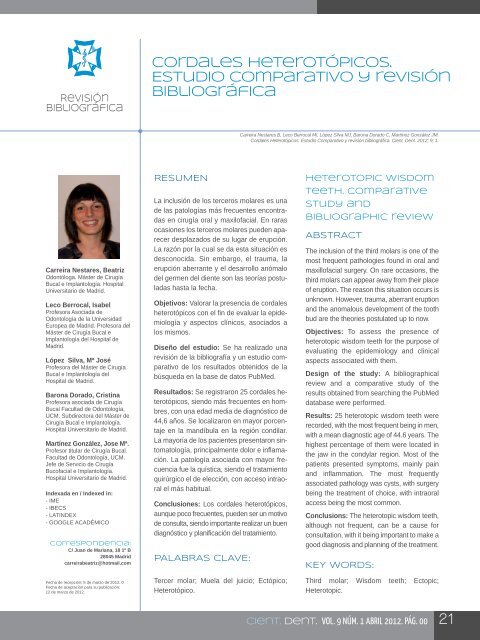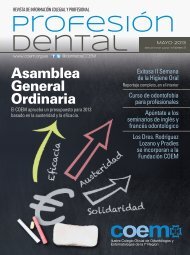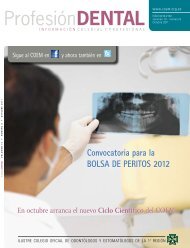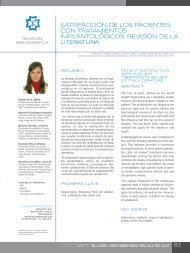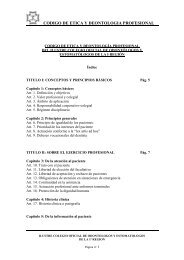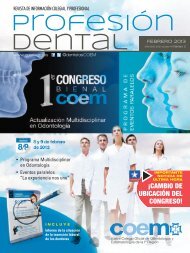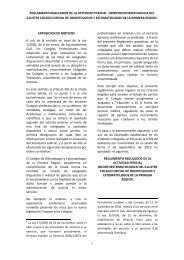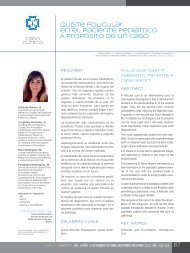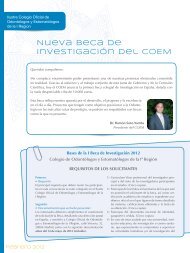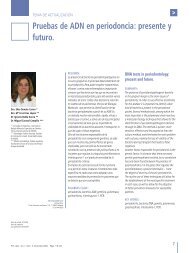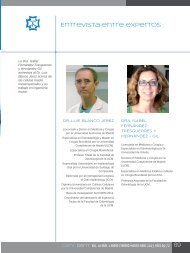Cientifica dental VOL 9-1_MaquetaciÃn 1 - COEM
Cientifica dental VOL 9-1_MaquetaciÃn 1 - COEM
Cientifica dental VOL 9-1_MaquetaciÃn 1 - COEM
You also want an ePaper? Increase the reach of your titles
YUMPU automatically turns print PDFs into web optimized ePapers that Google loves.
Revisión<br />
bibliográfica<br />
Cordales heterotópicos.<br />
Estudio comparativo y revisión<br />
bibliográfica<br />
Carreira Nestares B, Leco Berrocal MI, López Silva MJ, Barona Dorado C, Martínez González JM.<br />
Cordales Heterotópicos. Estudio Comparativo y revisión bibliográfica. Cient. Dent. 2012; 9; 1.<br />
Carreira Nestares, Beatriz<br />
Odontóloga. Máster de Cirugía<br />
Bucal e Implantología. Hospital<br />
Universitario de Madrid.<br />
Leco Berrocal, Isabel<br />
Profesora Asociada de<br />
Odontología de la Universidad<br />
Europea de Madrid. Profesora del<br />
Máster de Cirugía Bucal e<br />
Implantología del Hospital de<br />
Madrid.<br />
López Silva, Mª José<br />
Profesora del Máster de Cirugía<br />
Bucal e Implantología del<br />
Hospital de Madrid.<br />
Barona Dorado, Cristina<br />
Profesora asociada de Cirugía<br />
Bucal Facultad de Odontología,<br />
UCM. Subdirectora del Máster de<br />
Cirugía Bucal e Implantología.<br />
Hospital Universitario de Madrid.<br />
Martínez González, Jose Mª.<br />
Profesor titular de Cirugía Bucal.<br />
Facultad de Odontología, UCM.<br />
Jefe de Servicio de Cirugía<br />
Bucofacial e Implantología.<br />
Hospital Universitario de Madrid.<br />
Indexada en / Indexed in:<br />
- IME<br />
- IBECS<br />
- LATINDEX<br />
- GOOGLE ACADÉMICO<br />
Correspondencia:<br />
C/ Juan de Mariana, 18 1º B<br />
28045 Madrid<br />
carreirabeatriz@hotmail.com<br />
Fecha de recepción: 5 de marzo de 2012. 0<br />
Fecha de aceptación para su publicación:<br />
12 de marzo de 2012.<br />
RESUMEN<br />
La inclusión de los terceros molares es una<br />
de las patologías más frecuentes encontradas<br />
en cirugía oral y maxilofacial. En raras<br />
ocasiones los terceros molares pueden aparecer<br />
desplazados de su lugar de erupción.<br />
La razón por la cual se da esta situación es<br />
desconocida. Sin embargo, el trauma, la<br />
erupción aberrante y el desarrollo anómalo<br />
del germen del diente son las teorías postuladas<br />
hasta la fecha.<br />
Objetivos: Valorar la presencia de cordales<br />
heterotópicos con el fin de evaluar la epidemiología<br />
y aspectos clínicos, asociados a<br />
los mismos.<br />
Diseño del estudio: Se ha realizado una<br />
revisión de la bibliografía y un estudio comparativo<br />
de los resultados obtenidos de la<br />
búsqueda en la base de datos PubMed.<br />
Resultados: Se registraron 25 cordales heterotópicos,<br />
siendo más frecuentes en hombres,<br />
con una edad media de diagnóstico de<br />
44,6 años. Se localizaron en mayor porcentaje<br />
en la mandíbula en la región condilar.<br />
La mayoría de los pacientes presentaron sintomatología,<br />
principalmente dolor e inflamación.<br />
La patología asociada con mayor frecuencia<br />
fue la quística, siendo el tratamiento<br />
quirúrgico el de elección, con acceso intraoral<br />
el más habitual.<br />
Conclusiones: Los cordales heterotópicos,<br />
aunque poco frecuentes, pueden ser un motivo<br />
de consulta, siendo importante realizar un buen<br />
diagnóstico y planificación del tratamiento.<br />
PALABRAS CLAVE:<br />
Tercer molar; Muela del juicio; Ectópico;<br />
Heterotópico.<br />
Heterotopic wisdom<br />
teeth. Comparative<br />
study and<br />
bibliographic review<br />
ABSTRACT<br />
The inclusion of the third molars is one of the<br />
most frequent pathologies found in oral and<br />
maxillofacial surgery. On rare occasions, the<br />
third molars can appear away from their place<br />
of eruption. The reason this situation occurs is<br />
unknown. However, trauma, aberrant eruption<br />
and the anomalous development of the tooth<br />
bud are the theories postulated up to now.<br />
Objectives: To assess the presence of<br />
heterotopic wisdom teeth for the purpose of<br />
evaluating the epidemiology and clinical<br />
aspects associated with them.<br />
Design of the study: A bibliographical<br />
review and a comparative study of the<br />
results obtained from searching the PubMed<br />
database were performed.<br />
Results: 25 heterotopic wisdom teeth were<br />
recorded, with the most frequent being in men,<br />
with a mean diagnostic age of 44.6 years. The<br />
highest percentage of them were located in<br />
the jaw in the condylar region. Most of the<br />
patients presented symptoms, mainly pain<br />
and inflammation. The most frequently<br />
associated pathology was cysts, with surgery<br />
being the treatment of choice, with intraoral<br />
access being the most common.<br />
Conclusions: The heterotopic wisdom teeth,<br />
although not frequent, can be a cause for<br />
consultation, with it being important to make a<br />
good diagnosis and planning of the treatment.<br />
KEY WORDS:<br />
Third molar; Wisdom teeth; Ectopic;<br />
Heterotopic.<br />
cient. dent. <strong>VOL</strong>. 9 NÚM. 1 ABRIL 2012. PÁG. 00 21


